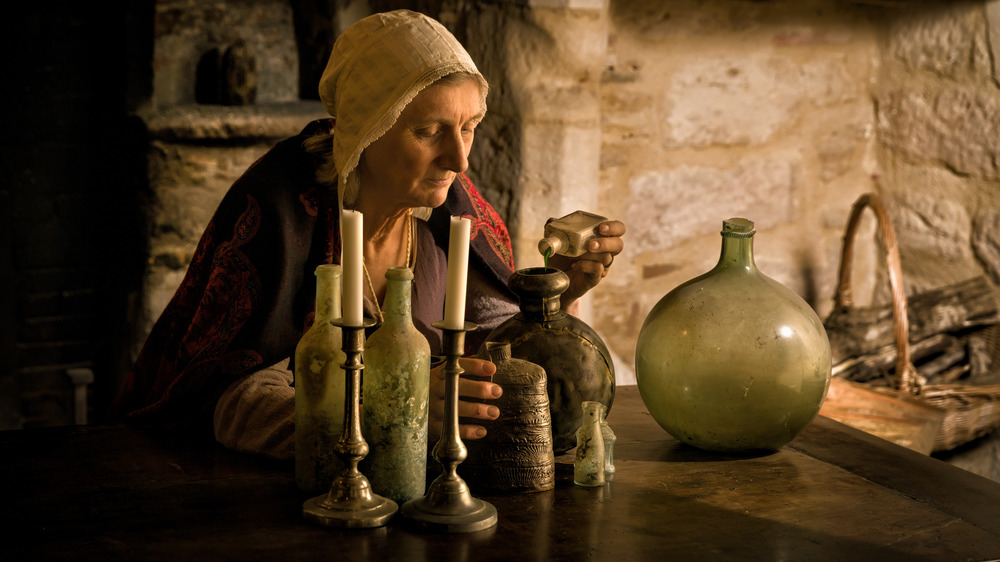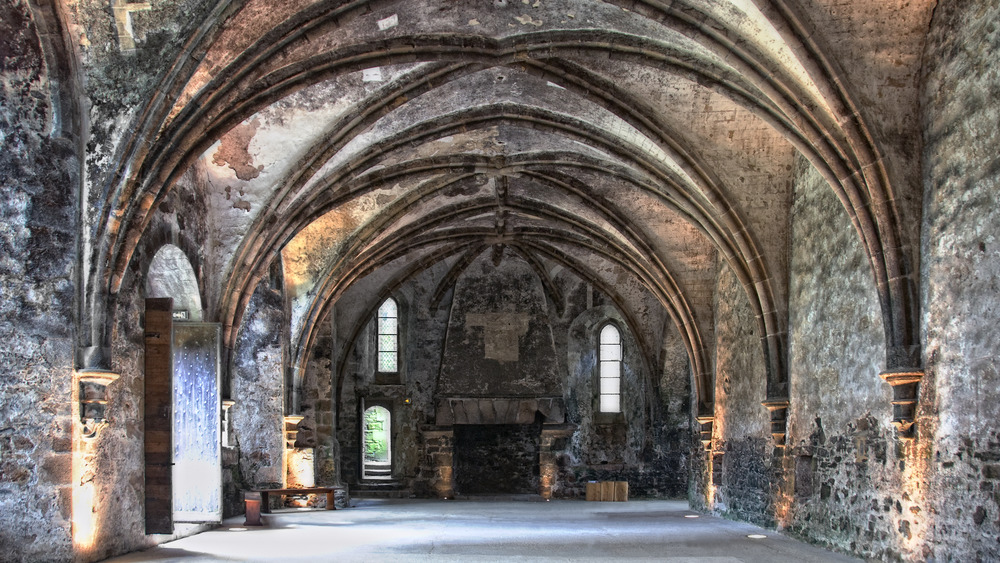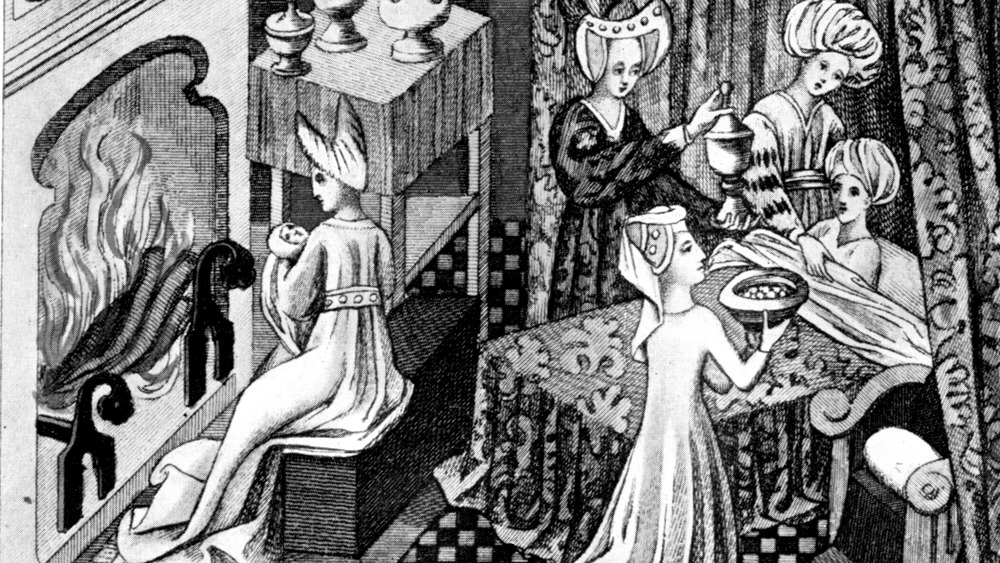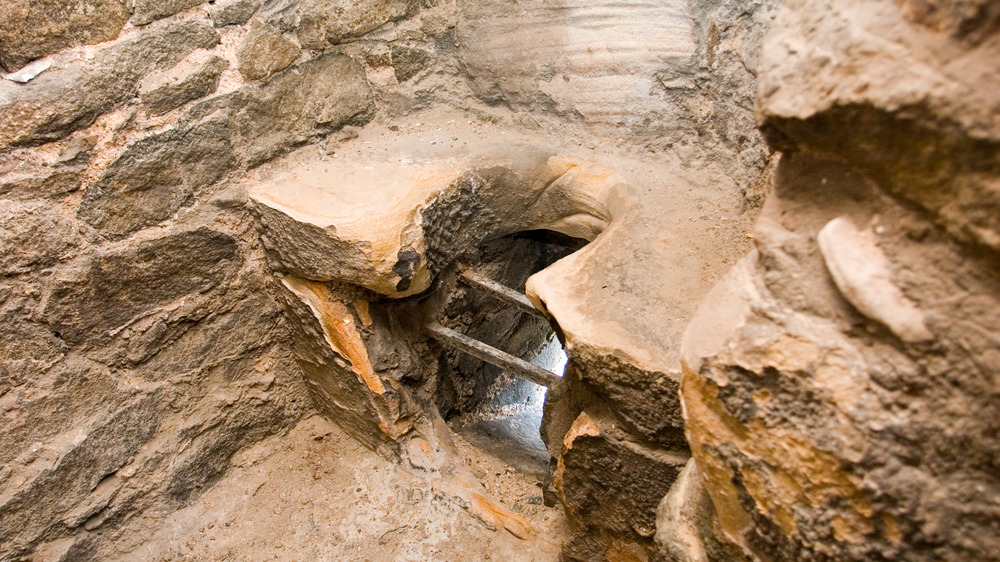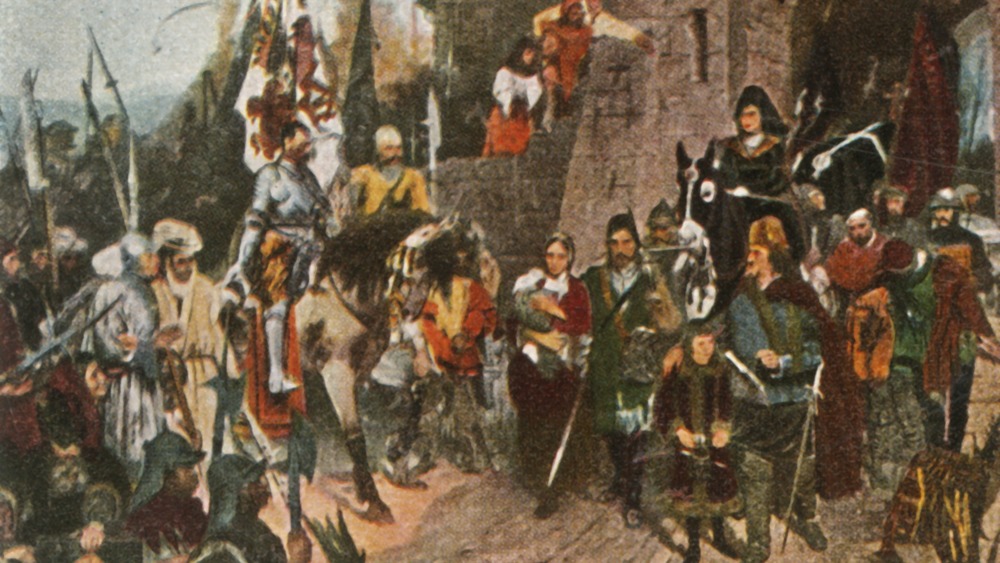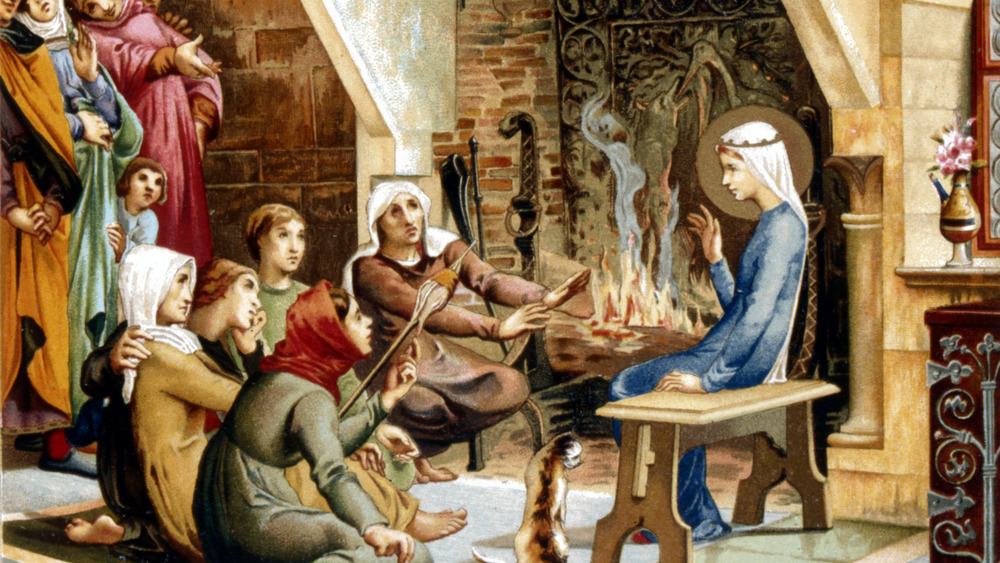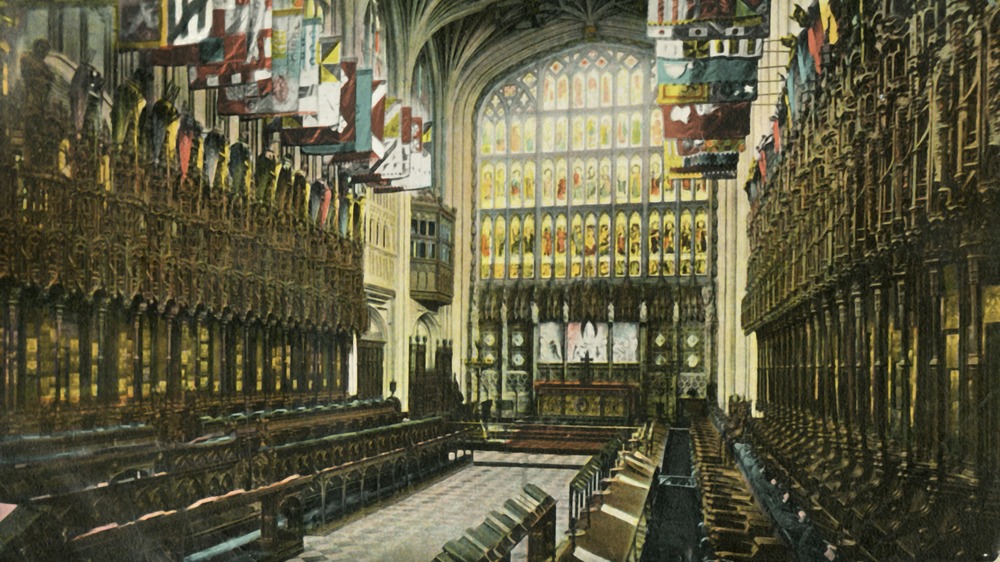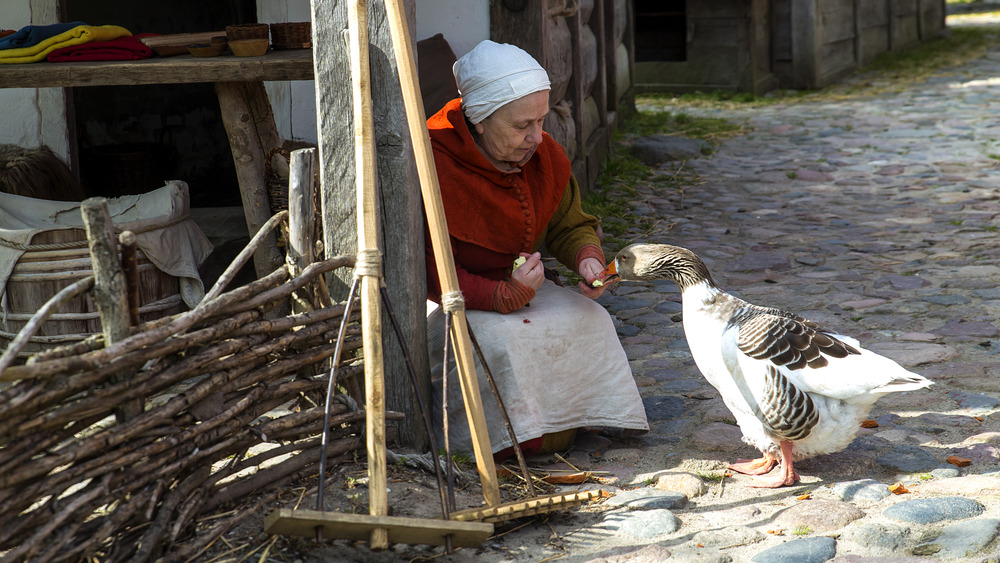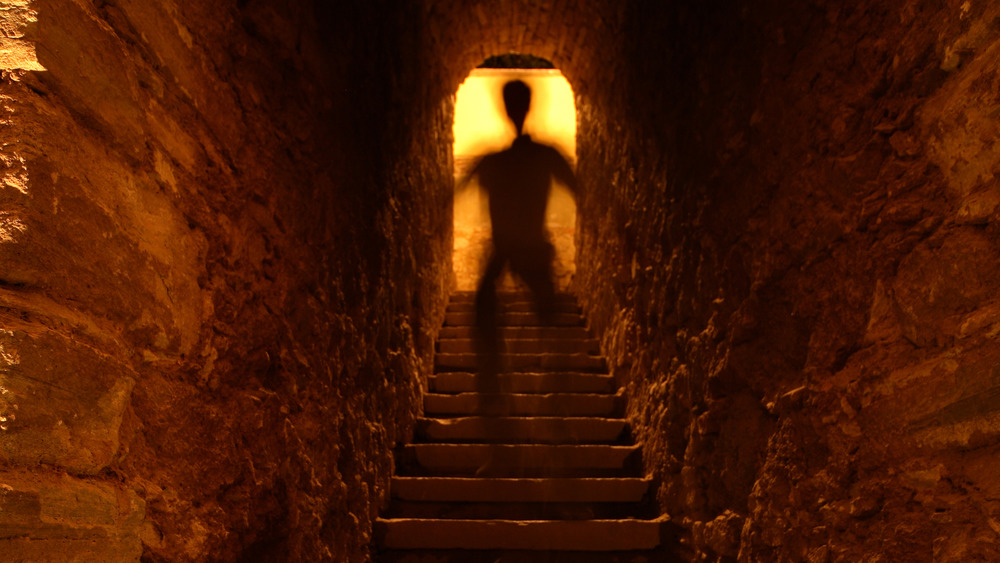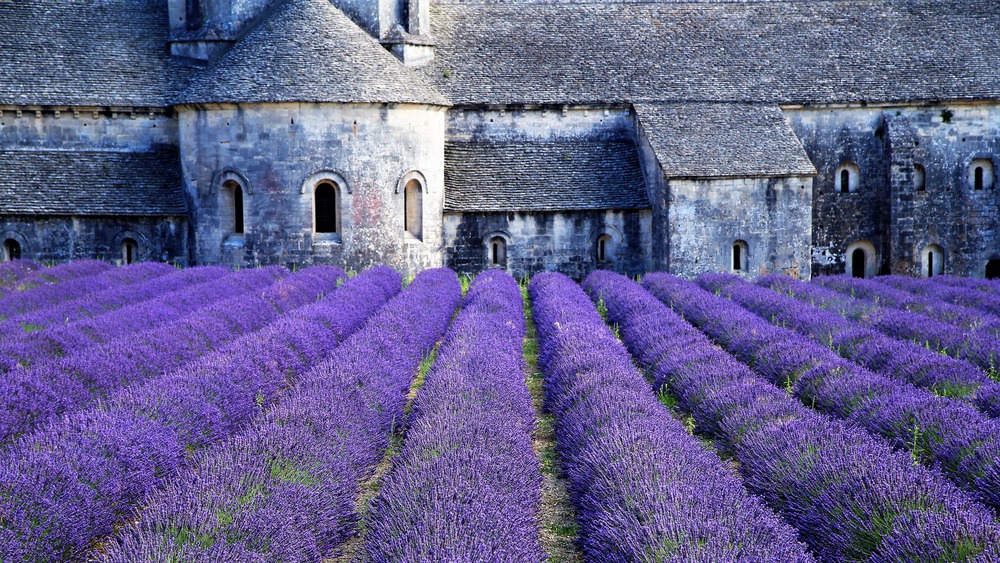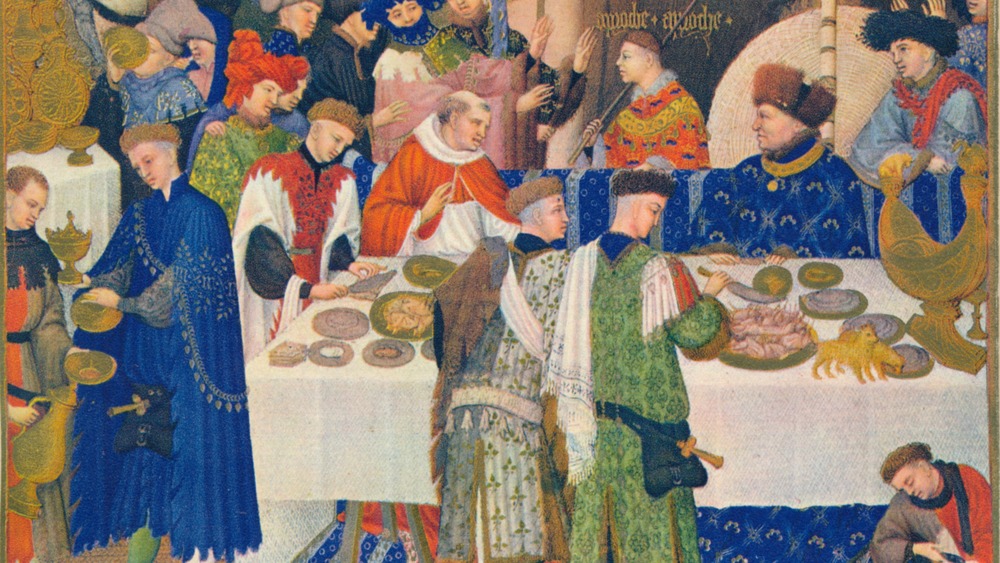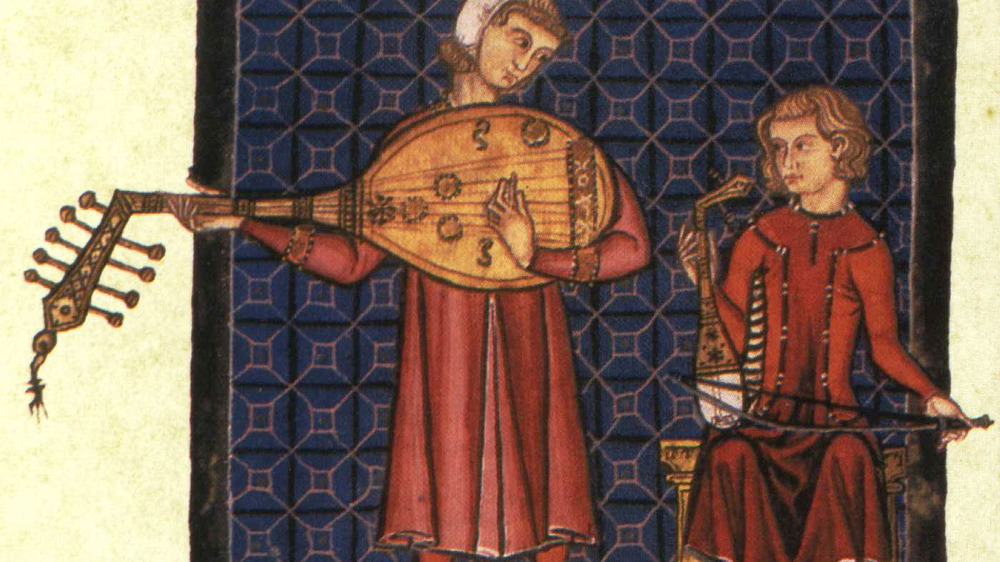What Life Was Really Like In A Medieval Castle
When it comes to dream homes, who doesn't have a castle on their list? People have been obsessed for a long time. History Daily says that one of the oldest castles in the world — the Citadel of Aleppo — was built somewhere around 3000 B.C., and that's a truly fun fact to pull out at parties.
By the Middle Ages, the importance of the castle was undeniable. They were built as the residences of the nobility and land-owning upper class, and let's face it — anyone who wants to live in the medieval era should definitely opt for being wealthy.
Ancient History says that while there is some variety across the different medieval castles still standing, there's a lot of similarities, too. Many were built on high ground, and proximity to water was a must. Over the course of centuries, castles grew from simple wooden palisades into motte and bailey castles — that is, a wall protecting a central courtyard and structures. Then, in the 12th century, many added the massive stone keeps, which served as the heart of the castle and the blueprint for every castle in every fantasy movie ever made.
So, what was it really like to live in one? Was it as awesome as it seems, or was it miserable? The truth is somewhere in between.
Most of the time, the medieval castle was pretty empty
What life in a medieval castle was like depended greatly on whether or not the lord (or lady) of the castle was there. Karen Dempsey of the University of Reading says that while castles were homes of the nobility, many weren't the family's permanent residence.
Many noble households would move from castle to castle, and since staff would travel too, households could have as many as 150 to 200 people. Moving was difficult, as literally everything — from tableware and tapestries to linens, candlesticks, and greenery — would be moved right along with the family. And it would happen often. English Heritage says that while King Henry III moved an average of 80 times a year, the Countess Joan de Valence (who had a moving household of almost 200 people) stayed at 15 different places between May of 1296 and September of 1297.
And that means life in the castle was very different depending on whether or not the family was there. When they were in residence, the castle would be a hustle and bustle of activity — particularly around the holidays or if they were also entertaining guests.
Otherwise, castle life could be pretty quiet. When the family left, a small, permanent staff would stay behind to keep everything safe, secure, and in working order. Unused rooms in the castle would be closed off, and daily life would be fairly quiet... at least, until the family came back.
Bedrooms had little in the way of privacy
Today, a typical bedroom might be a private sanctuary, but in a medieval castle, that wasn't the case at all. The medieval bedchamber also contained a sitting area where guests were received and entertained. Karen Dempsey of the University of Reading says that essentially, "private" meant something more along the lines of "exclusive." Think of it as a place where the lady of the house could hang out with all of her closest friends.
History Undressed notes that it's not unusual for medieval castles to only have a few rooms that serve as bedchambers, and those were reserved for the noble family. Everyone else was left to fend for themselves — knights, soldiers, servants, and even guests might sleep on the tables and benches in the great hall, and the luckiest might grab a space on pallets stuffed with straw. There weren't set sleeping arrangements, so when it was time to catch some 40-odd winks, it was every man, woman, and child for themselves.
And in the winter, a spot near the fire in the great hall was prime real estate.
Here's one more fun fact — ever see a tiny medieval bed and wonder if people were just shorter back then? That's not necessarily the reason for the small beds, and instead, it was because many people would sleep sitting up. Why? A superstition that laying flat was a position for the dead.
The bathrooms were really, really squicky
It's easy to take modern conveniences for granted, but here's a fun fact — toilet facilities in a medieval castle left much to be desired.
Ancient History says they were more commonly referred to as the garderobe or privy, but records of other euphemisms remain, too. Some castles called it the necessarium, which is appropriate, and the Golden Tower, which is hilarious.
The most common form was a room built on the outside of a castle wall. Occupants would simply sit over holes, do their business, and then that business would fall through to whatever happened to be below. Ideally, the garderobe would often be positioned over a river or a moat, but if that wasn't possible, they'd empty into cesspits that were occasionally cleaned out by farmers who would use the contents as fertilizer.
The bigger the castle, the more garderobes there would be... and anyone who couldn't do their business without having complete privacy might be out of luck. Some castles, says the Irish History Podcast, had garderobes built with multiple holes so they could accommodate a few people at once. Sure, it cuts down on waiting in line, but at what cost?
There were always soldiers around a medieval castle
At a basic level, medieval castles were designed for one thing — protection. It's not entirely surprising, then, that castle occupants would have to get used to sharing their space with soldiers.
According to English Heritage, the number of soldiers who were packed into a castle depended on whether or not there was a conflict going on. If things around were generally pretty peaceful, the military contingent of a castle might be made up of only about a dozen soldiers and the castellan who commanded them. Even during quiet times, they were a necessary part of castle life. They would be in charge of things like raising and lowering drawbridges and the portcullis and protecting residents against outside threats like bandits.
That would change during times of war, unrest, or other conflict. Depending on the size of the castle and necessity, hundreds of knights and soldiers could be transferred in. Factor in not just the men but their weapons, armor, and horses, and it's easy to imagine that things got pretty crowded pretty quickly.
There was a LOT of staff in a medieval castle
Working in a medieval castle might seem like a pretty sweet gig — especially considering that it afforded people more protection and security than they would have had working on the outside. But that didn't extend to job security, as according to Ancient History, the majority of castle staffers were paid daily, and when the lord or lady left, so did most of the jobs.
Like any company, the hierarchy of the medieval castle had certain workers at the top, who enjoyed things like job security, a yearly salary, and sometimes, even land of their own. Those were the people like the steward, the marshal, and the castellan. Knights could fall into this category, too, if they were permanently attached to a particular castle.
Then, there were all the people beneath them. A typical castle would have dozens and dozens of staff, from men-at-arms and guards to skilled craftsmen like blacksmiths, stone masons, and carpenters. Animals were kept by grooms, huntsmen, dog-handlers, and falconers, while the inside of the castle was the domain of a slew of domestic staffers. There were laundresses and chambermaids, cooks, undercooks, and cup-bearers, and most castles had a minstrel permanently employed there to provide everyone with a little light entertainment.
Scattered around the outside of the castle were the buildings and workshops of potters, candle-makers, rope-makers, and other skilled craftsmen who would take shelter inside the castle during times of war.
Medical care left a lot to be desired
A medieval castle could be home to hundreds if not thousands of people, and with all of those people, it's pretty much a guarantee that there's always going to be someone who's sick or injured. According to Medievalists, those people didn't have much in the way of options.
Medieval medicine changed a lot over the centuries, and early on, most of the medical advice would be given by a local healer who almost definitely didn't spend a decade at medical school. Instead, these healers — most of whom were illiterate — got their knowledge by studying with the previous generation of healers, who would have had quite a bit of experience.
Here's the thing — it wasn't all hocus pocus. Anyone suffering from aches and pains might, for example, be prescribed a dose of willow tree bark. Sounds weird? It isn't. Today, a synthetic version of the same prescription and ingredient is called aspirin.
Cures were mostly herbal, and it's no wonder that many castles (and monasteries) had their own herb gardens, with plants like sage, chamomile, dill, and cumin (via English Heritage). Healers would tell patients what they needed to collect, how to prepare it, and what special words and prayers to say while they were making — and taking — their own prescription. If more extreme measures were needed, it might be off to the castle barbers for a little surgical intervention. Yikes.
Religious services were incredibly important
For most people — from the lowliest of the kitchen boys to the lord and lady — religion was an incredibly important part of daily life. It's not entirely surprising, then, to learn (via Ancient History) that one of the most important parts of a medieval castle was the chapel. While there were different kinds of castle keeps built throughout the centuries, most included a two-story chapel that was used by all members of the castle household and staff.
Ancient Fortresses adds that it was the castle chapel that was usually the most elaborate of all castle buildings, and it's no wonder — people spent a lot of time there. Attending prayer services wasn't just a once-a-week thing, and everyone was expected to visit the chapel to pray four times each and every day. The first prayer would be said first thing in the morning, the second at noon, the third in the evening, and the final prayer would be the last thing many did before heading off to find somewhere to sleep.
On the plus side, they usually didn't have far to walk. Most medieval chapels were built off the great hall, although some particularly ingenious designs put it behind the gatehouse. Why? Anyone attacking would be attacking the chapel as well as the portcullis, and if your castle's going to fall, you might as well condemn your attackers to a little fire-and-brimstone style divine wrath while you're at it.
Life in a medieval castle came with experiences unique to women
Women living in a medieval castle had some specific rules they needed to follow — and some found brilliant ways around them. For one, Karen Dempsey of the University of Reading says women weren't allowed to touch the chapel altar... technically. Instead, they found other ways to touch the divine — many would use their own clothes to make altar cloths or clothes for the castle's clergy.
In many cases, the lady of the house had many of the same powers as her husband, particularly when he was away. Whether he was gone on a day's hunt or a decade's crusade, noblewomen could run the estate, put their seals on official documents, and oversee the castle's defense.
There's another part of castle life that's unique to women — menstruation. According to historians Karen Harris and Lori Caskey-Sigety (via On the Tudor Trail), medieval women used things like cotton or bog moss — sometimes wrapped around a twig — as olde-timey sanitary napkins and tampons. Stains were predictably common, so visitors to a medieval castle would typically see a lot of women wearing red clothing.
Medieval women, however, had to deal with visits from "Aunt Flo" less than modern women, for a few reasons. Poor diet and hard physical labor meant many would go months without said visit, and menopause happened much earlier than it does today.
You probably shared your living space with some ghosts
It's a given that a medieval castle is going to come with ghost stories, as they have hundreds of years of history contained within their walls. But, the medieval people living in those castles when they were still fairly new shared stories of the ghosts who lived there, too.
Ghost stories from the Middle Ages make modern ghost stories look like the work of complete amateurs. Take the tale told by a priest named Walchelin and written down in 1091 (via the London Review of Books). He claimed to have seen an army of the dead, made up of commoners who walked while weighed down by heavy burdens and women who rode on saddles of burning nails. Knowing that no one would believe his story, he tried to hop on one of the riderless horses, and he carried the scars from the reins and stirrups for the rest of his life.
According to Medievalists, it wasn't uncommon for people in the Middle Ages to tell tales of seeing ghosts. It was often said that the spirits were Christian souls trapped in purgatory, reaching out in the hope that they would say prayers or perform good deeds in their memory to shorten their penance. In other places, women would return to check on the children of their descendants, and it was often said that those suffering from insomnia might get a visit from a spirit who wanted to help them sleep.
It didn't smell as bad as you might think
It's easy to imagine that a castle — with little air flow and a ton of people living in close quarters — might smell pretty bad, but those living there went to great lengths to keep the smell from being intolerable.
Trivium says that castles — which on their own could smell damp and musty at best — were often filled with sweet-smelling herbs and other plants. Rushes were used to cover the floors (and were replaced frequently), and the wealthiest families also used plants like lavender, hyssop, thyme, and meadowsweet.
Research published in Heart Views says that it wasn't just the floors that would be covered with fragrant plants. Baths would have been scented with herbs and flowers (including roses), and scented garlands would have been hung in many rooms. When crusaders started returning from the Middle East, they brought back all kinds of new perfumes and scents. Castle inhabitants would have washed their hands and faces every morning — usually with rosewater — and daily rituals would have finished with a dusting of powders scented with things like cloves and lavender.
Scented flowers and herbs were often prescribed for daily aches and pains — sage, hay, and lavender were used for headaches and joint pain, and coriander was used for a fever. English Heritage also points out that through the Middle Ages, it was believed that bad smells caused illness — so they went to extreme measures to keep things smelling as pleasant as possible.
Food was a big deal
Feeding the inhabitants of a medieval castle was a full-time job for scores of people — and it wasn't cheap. Take the household of Joan De Valence. English Heritage says that she spent around 40% of her entire income just feeding her household.
There were a lot of people employed to do all the prep and cooking, too. Castles and Manor Houses says that many medieval castles had not just cooks on hand but people like the pantler (who was in charge of the pantry, which included things like bread and cheese), a confectioner, a poulterer, and even a spicer.
They worked all day, too. Ancient History says there were usually three meals served over the course of the day, starting with a breakfast that typically included just some bread and wine. The largest meal was served next — usually between 10 a.m. and noon — and the third afternoon meal was also small. Diners would be summoned to the great hall by the blowing of a horn, and yes, they would wash up first. Typically, diners were served in groups of two, and it was the lower-ranking person's task to cut the meat or bread. And table manners were of the utmost importance. Diners were asked not to leave their personal utensils in communal dishes, keep elbows off the table, and not to burp.
Fun times!
Life in a medieval castle wasn't a matter of all work and no play. Feasts didn't happen every week, but when they did, they were a huge deal that came not just with tons of food but with entertainment from minstrels, bards, jugglers, musicians, and jesters. Different areas had different celebrations. According to the BBC, the Feast of Fools was unique to Scotland, and it was basically a massive drink-fest overseen by the "Abbot of Unreason."
Karen Dempsey of the University of Reading says that children were often given toys and games to play with, including metal animals with moving parts to miniature furniture.
Meanwhile, adult pastimes served dual purposes. Hunting and hawking were considered hobbies of the castle's elite, but it also helped keep the larder stocked with things like deer, boar, and rabbit. Sports, too, served two purposes — activities like jousting, bowling, archery, and wrestling were fun, but they were also a bit of military training disguised as friendly competition.
Ancient History says other popular pastimes included things like needlework, playing and composing music, and playing games like chess, dice, and backgammon. Gambling was fairly common — and didn't carry any of the stigma that it does today — and parlor games were as common among adults as they were among children. Who needs Netflix?
